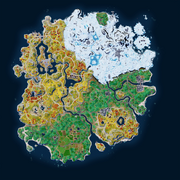If your students could pick the lesson content, there's a fair chance Fortnite would end up in every subject, every day, forever. And while we’re not turning classrooms into LAN parties (relax, leadership team), there’s actually a goldmine of learning opportunities tucked inside the world of Battle Royale.
So here’s the hack: you don’t need to play Fortnite in the classroom - you just need to use it as a context. It’s a shared language your students already understand. You can take that world, flip it into a lesson, and watch the engagement skyrocket.
Here’s how.
Maths: Loot, Maps, and Safe Zones
Fortnite is secretly full of maths. Geometry, statistics, measurement, and problem solving are baked into the gameplay - and we can tap into that without touching a controller.
Mapping the Island
Use an overhead view of the Fortnite map (e.g., this one from Fortnite Wiki) to:
- Practice coordinates and grid referencing
- Estimate area and perimeter of zones
- Discuss scale and measurement
- Track storm movement using time/distance problems
Task idea: “The storm moves from a 5x5 grid to a 2x2 over 60 seconds. How far does each side shrink per second?”

Loot Drop Data and Probability
Turn item drop rates into a stats lesson:
- Compare common, rare, and legendary item frequencies
- Represent data in tables, graphs, and pie charts
- Calculate simple probabilities:
“What’s the chance of getting a shield potion in a chest?”
You can grab item drop stats from fan sites like Fortnite Wiki or let students simulate loot drops with dice and random number generators.
Bonus resource: This Probability Spinner is great for simulating loot chest outcomes.
English: Narrative, Persuasive, and Descriptive Gold
Let’s talk literacy. Fortnite is basically one giant story engine - characters, settings, conflict, quests. Here’s how to tap into it.
Creative Writing with a Battle Twist
Use Fortnite locations (like Tilted Towers or Lonely Labs) as writing prompts:
- Write a narrative set during a storm collapse
- Describe a last-player-standing moment using sensory details
- Build character backstories for in-game skins or original heroes
Prompt example:
“The air buzzed with the storm’s static as I crouched behind a crumbling wall. Ten players. One circle. No second chances.”
Pair this with Fortnite images from Epic’s Creative Hub or use screenshots you’ve sourced yourself.

Persuasive Texts: Should Fortnite Be in Schools?
Get students to write opinion pieces or debate:
- Should Fortnite be considered a sport?
- Are in-game purchases worth it?
- What weapon/item should Epic add next?
Let them present pitches to the class Shark Tank-style, or create a mock blog post, tweet, or video ad.
Helpful template: Try this Persuasive Writing Scaffold from Twinkl.
Critical Thinking + Group Tasks
You can also go cross-curricular and sneak in collaboration and decision-making.
Battle Royale Decision Trees
- Design a survival plan: where to drop, what to collect, who to avoid
- Use decision trees and flowcharts to show outcomes
- Reflect on which strategies work and why
Pair this with tools like Google Slides or Canva’s free templates.
Twist it: Make it a team task. Each group presents their "winning strategy" with logic and reasoning.
Fortnite-Themed Rewards & Engagement
Even if you're not doing a full Fortnite lesson, you can still use the theme for:
- XP-style point systems (e.g., complete tasks to “level up”)
- Loot cards (students pick rewards from a random chest)
- Team-based "squad" challenges
Try this: Use the Wheel of Names to simulate loot chest surprises.
You don’t need to love Fortnite. You just need to know your students do, and that’s your secret weapon. By pulling the game world into your classroom (in clever, controlled ways), you’re instantly speaking their language while still hitting learning outcomes.
So the next time you’re staring down a disengaged class and thinking "How do I hook them?", drop in from the Battle Bus and give this Fortnite hack a go. Victory Royale optional. Learning? Guaranteed.


